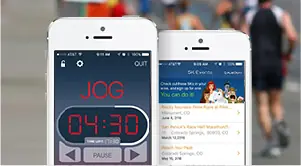"If you're not getting your period, that's a problem." - Laura Dunne, M.D.
As a sports-medicine physician and a runner, Dunne often fields injury-related questions from women. But amid the talk of tendinitis, runners tend to ignore one less painful sign of overtraining: the lack of a monthly period. "Most runners don't even recognize it as a warning signal," says Dunne.Unless they've gone through menopause, women should get regular periods. Their absence means that the body is not getting enough fuel for healthy reproductive life, says Dunne.
The condition (called amenorrhea) can occur in any woman whose body fat levels dip below 17 percent. And if you don't have enough energy for reproductive health, you can bet your body's not rebuilding muscle, either.
More from ACTIVE: The Ultimate Running Guide for Women
"Postworkout recovery suffers, and injuries such as stress fractures become more likely," Dunne says. That's because the body borrows what it needs from bone tissue, which weakens the skeleton and may result in osteoporosis later in life. Once weakened by amenorrhea, bone density is not likely to rebound.
The solution?
Take in more calories, now.
Heavy training loads aren't the culprit; if you're at the peak of your marathon training and miss a period, you're underfueling. Determine how much fuel you need by using the calculator at runnersworld.com/caloriecalculator.
Remember: If you're running more, you'll need to eat more—every mile burns roughly 100 calories. If you're playing catch-up, make those calories heavy on healthy fats (which give your body the building blocks it needs to make hormones). Dunne recommends targeting nut butters, olive oil, avocado, and fish-oil supplements.
More From Runner's World: 5 Surprising Truths About Calories
"A little yoga goes a long way." - Yoga Instructor Rebecca Pacheco
Runners tend to bring their competitive spirit with them to the yoga studio, says Pacheco, a yoga instructor and two-time marathoner who founded OmGal.com. But an hours-long asana marathon isn't what most runners really need, because with yoga—as with running—consistency is key.
"It's better to do 10 minutes of daily yoga than an intense, 90-minute session once a month," says Pacheco. Shorter, more frequent doses reinforce correct alignment and gently nudge muscles to relax. After your run and on your cross-training days, try these moves, which "support recovery and help prep muscles for your next workout," says Pacheco.
More from ACTIVE: Boost Running Performance With Yoga
Downward Dog
"This pose lengthens the back of the body, including the spine, hamstrings, and calves—which are among runners' most overused muscles," says Pacheco. Starting on your hands and knees, lift your hips into the air, pointing your tailbone toward the ceiling while easing your heels toward the floor.
"I encourage runners to move a bit in this pose, pedaling the feet to massage the plantar fascia," she says. If the pose feels too intense for your hamstrings, it helps to bend your knees slightly. Hold for five to 15 breaths.
Legs Up The Wall
This pose "neutralizes the spine and rests tired legs and feet," Pacheco says. Lie down next to a wall, with your buttocks close to its base, and swing your legs up against the wall. Allow your arms to rest along your sides. Hold for up to 10 minutes.
More From Runner's World: The Runner's World Yoga Center
- 3
- of
- 5
About the Author











Discuss This Article